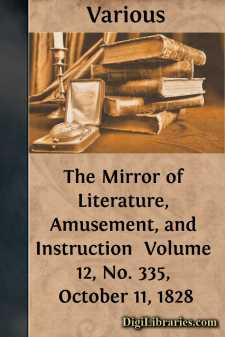Categories
- Antiques & Collectibles 13
- Architecture 36
- Art 48
- Bibles 22
- Biography & Autobiography 813
- Body, Mind & Spirit 142
- Business & Economics 28
- Children's Books 17
- Children's Fiction 14
- Computers 4
- Cooking 94
- Crafts & Hobbies 4
- Drama 346
- Education 46
- Family & Relationships 57
- Fiction 11829
- Games 19
- Gardening 17
- Health & Fitness 34
- History 1377
- House & Home 1
- Humor 147
- Juvenile Fiction 1873
- Juvenile Nonfiction 202
- Language Arts & Disciplines 88
- Law 16
- Literary Collections 686
- Literary Criticism 179
- Mathematics 13
- Medical 41
- Music 40
- Nature 179
- Non-Classifiable 1768
- Performing Arts 7
- Periodicals 1453
- Philosophy 64
- Photography 2
- Poetry 896
- Political Science 203
- Psychology 42
- Reference 154
- Religion 513
- Science 126
- Self-Help 84
- Social Science 81
- Sports & Recreation 34
- Study Aids 3
- Technology & Engineering 59
- Transportation 23
- Travel 463
- True Crime 29
The Mirror of Literature, Amusement, and Instruction Volume 12, No. 335, October 11, 1828
by: Various
Categories:
Description:
Excerpt
LAVENHAM CHURCH.
Lavenham, or Lanham, a small town north of Sudbury, was once eminent for its manufactures, when there were eight or nine cloth-halls in the place, inhabited by rich clothiers. The De Veres, Earls of Oxford, whose names are blazoned in our history, held the manor from the reign of Henry I. till that of Elizabeth, and one of the noble family obtained a charter from Edward III. authorizing his tenants at this place to pass toll-free throughout all England, which grant was confirmed by Elizabeth. But the manufacturing celebrity of Lavenham has dwindled to spinning woollen yarn, and making calimancoes and hempen cloth; the opulent clothiers have shuffled off their mortal coil, and proved that “the web of our life is of a mingled yarn, good and ill together.”
The church of Lavenham is, however, a venerable wreck of antiquity, and is accounted the most beautiful fabric of the kind in Suffolk. It is chiefly built of freestone, the rest being of curious flintwork; its total length is 150 feet, and its breadth 68. From concurrent antiquarian authorities we learn that the church was built by the De Veres, in conjunction with the Springs, wealthy clothiers at Lavenham. This is attested by the different quarterings of their respective arms on the building. The porch is an elegant piece of architecture, very highly enriched with the shields, garters, &c. of many of the most noble families in the kingdom, among which are the letters I.O., probably intended for the initials of John, the 14th Earl of Oxford, who married the daughter of Thomas Howard, Duke of Norfolk. He is conjectured to have erected this porch.
In the interior, the roof is admirably carved, and the pews belonging to the Earls of Oxford and the Springs, though now much decayed, were highly-finished pieces of Gothic work in wood. Some of the windows are still embellished with painted glass, representing the arms of the De Veres and others. Here also is a costly monument of alabaster and gold, erected to the memory of the Rev. Henry Copinger, rector of Lavenham, with alto-relievo figures of the reverend divine and his wife.
In the north aisle is a small mural monument, upon which are represented a man and woman, engraved on brass, kneeling before a table, and three sons and daughters behind them. From the mouth of the man proceeds a label, on which are these words:—In manus tuas dne commendo spiritum meum. Underneath is this inscription, which, like that of the label, is in the old English character:—
Contynuall prayse these lynes in brasse,
Of Allaine Dister here,
A clothier, vertuous while he was
In Lavenham many a yeare.
For as in lyefe he loved best
The poore to clothe and feede,
So with the rich and all the rest
He neighbourlie agreed;
And did appoynte before he dyed,
A special yearlie rent,
Which should be every Whitsontide
Among the poorest spent.
Et obiit Anno Dni 1534.
Although this benefaction is written in brass, the good man’s successors have found enough of the same metal to pervert it; for it is now lost, and no person can give any account of it....












